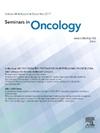解读黑色素瘤的预后价值和免疫治疗策略:整合单细胞测序和机器学习
IF 2.5
3区 医学
Q2 ONCOLOGY
引用次数: 0
摘要
本研究旨在探讨聚集性在皮肤黑色素瘤(CM)中的作用,并探讨其作为预后和治疗靶向的生物标志物的潜力。我们利用单细胞测序技术和机器学习算法分析来自TCGA数据库的黑色素瘤转录组数据,并使用来自GEO数据库的3个独立数据集验证我们的发现。通过在单细胞测序中使用富集评分,我们确定了不同细胞类型参与聚合的特征表达模式,并构建了聚合相关特征(ARS)。我们进一步评估了ARS与临床特征、免疫细胞浸润、肿瘤突变负荷(TMB)和免疫检查点基因表达的关系。此外,我们利用shRNA进行了体内实验,通过敲除ARS中最关键的致癌基因TPX2,并通过小鼠皮下肿瘤形成实验和流式细胞术评估了其对肿瘤增殖和t细胞生长的影响。ARS在多个数据集中显示出强大的预后预测能力,较高的ARS评分与较差的总生存率(OS)和较低的免疫细胞浸润水平相关。ARS评分低的患者更有可能受益于免疫检查点抑制剂治疗,而评分高的患者对两种常见化疗药物的敏感性增加。与已发表的黑色素瘤预后模型相比,我们的ARS显示出更高的准确性和稳定性。构建与急性呼吸道综合征相关的nomogram图,进一步提高了临床决策的准确性。体内实验证实,TPX2敲低抑制肿瘤增殖,增强t细胞生长,突出其在CM进展中的关键作用。我们的研究强调了皮肤黑色素瘤中聚集相关特征的复杂功能,强调了其作为治疗靶点和预后评估的有价值工具的潜力。本文章由计算机程序翻译,如有差异,请以英文原文为准。
Deciphering the prognostic value and immunotherapeutic strategy of aggrephagy in melanoma: Integrating single-cell sequencing and machine learning
This study aimed to investigate the role of aggrephagy in cutaneous melanoma (CM) and explore its potential as a biomarker for prognosis and therapeutic targeting. We utilized single-cell sequencing technology and machine learning algorithms to analyze melanoma transcriptome data from the TCGA database and validated our findings using 3 independent datasets from the GEO database. By employing enrichment scoring in single-cell sequencing, we identified characteristic expression patterns of different cell types involved in aggrephagy and constructed an aggrephagy-related signature (ARS). We further evaluated the association of ARS with clinical features, immune cell infiltration, tumor mutational load (TMB), and immune checkpoint gene expression. Additionally, we conducted in vivo experiments by knocking down TPX2, the most critical oncogene in ARS, using shRNA and assessed its effects on tumor proliferation and T-cell growth via subcutaneous tumor formation assays and flow cytometry in mice. The ARS demonstrated robust prognostic predictive power across multiple datasets, with higher ARS scores associated with poorer overall survival (OS) and lower levels of immune cell infiltration. Patients with low ARS scores were more likely to benefit from immune checkpoint inhibitor therapies, while those with high scores exhibited increased sensitivity to 2 common chemotherapeutic agents. Compared to published melanoma prognostic models, our ARS showed higher accuracy and stability. The construction of an ARS-related nomogram further facilitated more accurate clinical decision-making. In vivo experiments confirmed that TPX2 knockdown inhibited tumor proliferation and enhanced T-cell growth, highlighting its critical role in CM progression. Our study highlights the complex functions of the aggrephagy-related signature in cutaneous melanoma, underscoring its potential as a therapeutic target and a valuable tool for prognostic assessment.
求助全文
通过发布文献求助,成功后即可免费获取论文全文。
去求助
来源期刊

Seminars in oncology
医学-肿瘤学
CiteScore
6.60
自引率
0.00%
发文量
58
审稿时长
104 days
期刊介绍:
Seminars in Oncology brings you current, authoritative, and practical reviews of developments in the etiology, diagnosis and management of cancer. Each issue examines topics of clinical importance, with an emphasis on providing both the basic knowledge needed to better understand a topic as well as evidence-based opinions from leaders in the field. Seminars in Oncology also seeks to be a venue for sharing a diversity of opinions including those that might be considered "outside the box". We welcome a healthy and respectful exchange of opinions and urge you to approach us with your insights as well as suggestions of topics that you deem worthy of coverage. By helping the reader understand the basic biology and the therapy of cancer as they learn the nuances from experts, all in a journal that encourages the exchange of ideas we aim to help move the treatment of cancer forward.
 求助内容:
求助内容: 应助结果提醒方式:
应助结果提醒方式:


